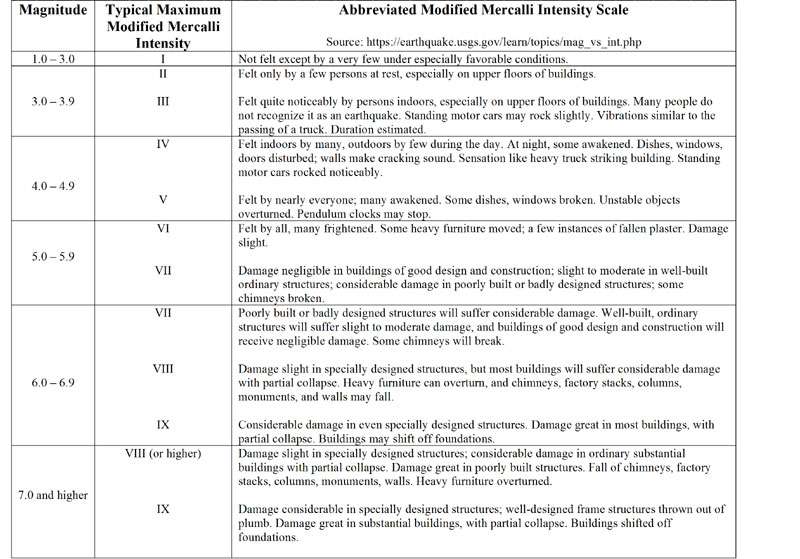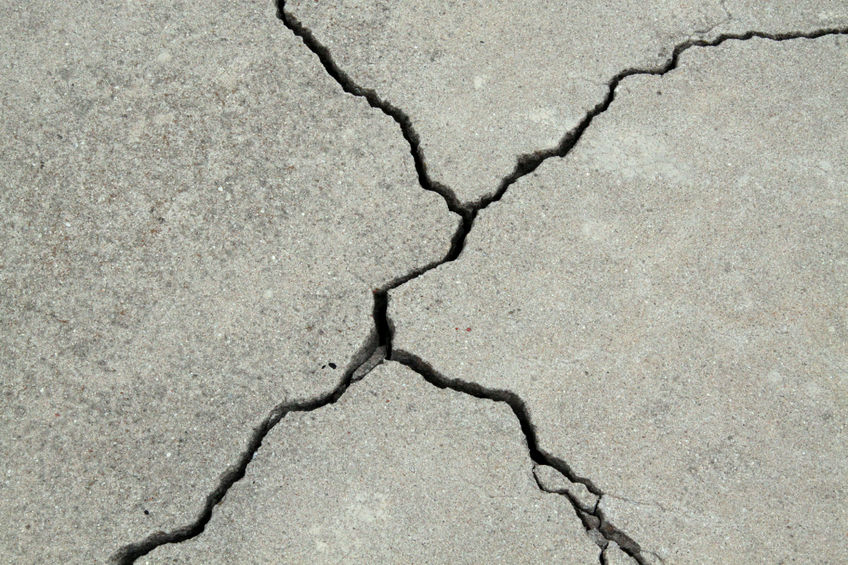| University of Colorado at Boulder | ||||||||
 |
||||||||
|
Does wastewater injection induce earthquakes? If so, what kind of damage can result? How are communities affected? And how does the public perceive induced seismicity? These are just a few of the questions that researchers are addressing regarding induced seismicity related to wastewater injection. EARTHQUAKE DAMAGEScientists usually use the Mercalli Intensity Scale to characterize the effects of an earthquake on people, human structures and the natural environment.
To date, most of the earthquakes thought to be induced by wastewater disposal have been small and, consequently, have not been felt by the public nor caused noticeable damage. But how does damage from these man-made tremors differ from natural earthquakes? At the University of Colorado, the IS Collaboratory is currently investigating various aspects of IS including the Fragility of Buildings and Building Components and developing Engineering Risk Assessments for Induced Seismicity (Researcher Liel, with USGS collaborators). The Liel team is investigating how induced events influence our understanding of earthquake risks and the risks of damage associated with IS -- both essential to improve risk management and mitigation. For example, induced events can have ground shaking characteristic that can lead to different damage patterns than a naturally occurring event. Their research approach to determine the fragility of buildings and building components in the context of IS consists of two tasks. The first task includes characterizing the engineering properties of ground motion recordings from injection-induced earthquakes. This particular task requires gathering a set of recorded ground motions from induced earthquakes and small magnitude tectonic earthquakes. The second task will use analytical simulation models of buildings to determine the fragility of these systems in response to induced earthquake events. This task will develop nonlinear models of structures and non-structure elements that have been damaged by induced earthquakes. The team will ultimately use models to investigate the relationship between IS and building damage. The project will (1) compare the characteristics of structural response under induced earthquakes to the response under tectonic earthquakes, and (2) determine the fragility of buildings, building components and infrastructure to small magnitude earthquakes produced by injection-induced earthquakes. Liel’s team will also be gathering results from other Collaboratory researchers as well as additional information from the USGS Seismic Hazard Mapping Team in order to complete the seismic hazard analyses for their case study communities. This analysis will estimate the probability of an earthquake occurring given a particular injection rate and estimate the conditional probability of different magnitude earthquakes occurring. Furthermore, the team will use a sensitivity study to determine which parameters are most important from the perspective of the assessment of seismic hazard. The objectives of this case study are to (1) identify the most useful seismic hazard information for different stakeholders, (2) establish the influence that induced events have on the seismic hazards found at the case study locations, (3) distinguish the risks of damage to buildings and infrastructure due to induced seismicity, and (4) determine the influence that traffic light policies, seismic monitoring programs, changes in injection rates or other regulatory actions have on the assessments of risk. For more information on the regulatory controls on IS, see Regulating Underground Injection. Community ConcernsConsidering the extent of oil and gas development in states that have experienced induced seismicity, few individuals have been directly affected by earthquakes. But communities across the country grapple with decisions about whether to support or oppose oil and gas development in the context of the resource gains and losses they perceive from these activities. Currently, much of the information available to communities about oil and gas development consists of poorly supported claims and counter-claims, and information about induced seismicity, in particular, is extremely limited. Furthermore, while controversy surrounding the latest technological advancements in oil and gas development is on the rise, little is known about the relationship between how communities perceive the various risks of this development and how the development itself and perceived risks influence community stress and disruption. Two teams of the University of Colorado’s IS Collaboratory are looking at potential community impacts and perceptions of induced seismicity. The Javernick-Will team is analyzing Community Networks & Knowledge Sharing; the Ritchie team is looking at Community Impacts & Risk Perceptions. The Javernick-Will team is collecting, analyzing, and assessing information and knowledge dissemination about unconventional oil and gas development within case study communities in Colorado and Oklahoma. The team has conducted initial interviews for community actors and conducted an initial mail survey. Ultimately, this research will better understand the types of information and information distribution mechanisms being used by community members to inform and mobilize in support of or in opposition to oil and gas development, and the community network and information-sharing structures that emerge in communities where these activities are occurring. To accomplish these goals, researchers are (1) identifying the actors and groups that are mobilizing at the community level in support of or opposition to the oil and gas development activities associated with IS, (2) establishing how groups are mobilizing and organizing to respond to these activities and the characteristics that develop from information sharing networks, (3) distinguishing the information about risks associate with industrial activities that is used and disseminated to support groups’ interests and positions, (4) determining how the type of evidence used and network structure enable or constrain the development and achievement of their goals and behavior, and (5) determining how the information about risk of IS generated from this research is adopted and disseminated within these community knowledge-sharing networks. In their investigation of risks, stress and community disruption, the Ritchie team is integrating three empirically-based theoretical approaches: (1) the ecological-symbolic perspective, (2) the concept of a renewable resource community (RRC) and (3) the conservation of resources (COR). The study includes in-depth interviews of a representative sample of key stakeholders and household telephone surveys in Colorado and Oklahoma. Developments from other collaboratory researchers will be utilized to identify additional correlations and trends. The objectives of this study are to (1) identify how the communities’ ties to the natural environment affect opinions about oil and gas development activities (2) identify how these oil and gas development activities affect the communities’ relationship with the natural environment, (3) determine how individuals and groups in communities evaluate risks and benefits associated with oil and gas development, (4) establish the key factors influencing the decision-making related to support/lack of support for oil and gas development, (5) distinguish the relationship between beliefs about risks related to oil and gas development, individual and collective stress, and social disruption, (6) characterize the relationship between documented physical impacts of oil and gas development in a given area and perceptions of risk, and (7) illustrate the relationship between beliefs about economic impacts or oil and gas development and perceptions of risk.
|
||||||||


